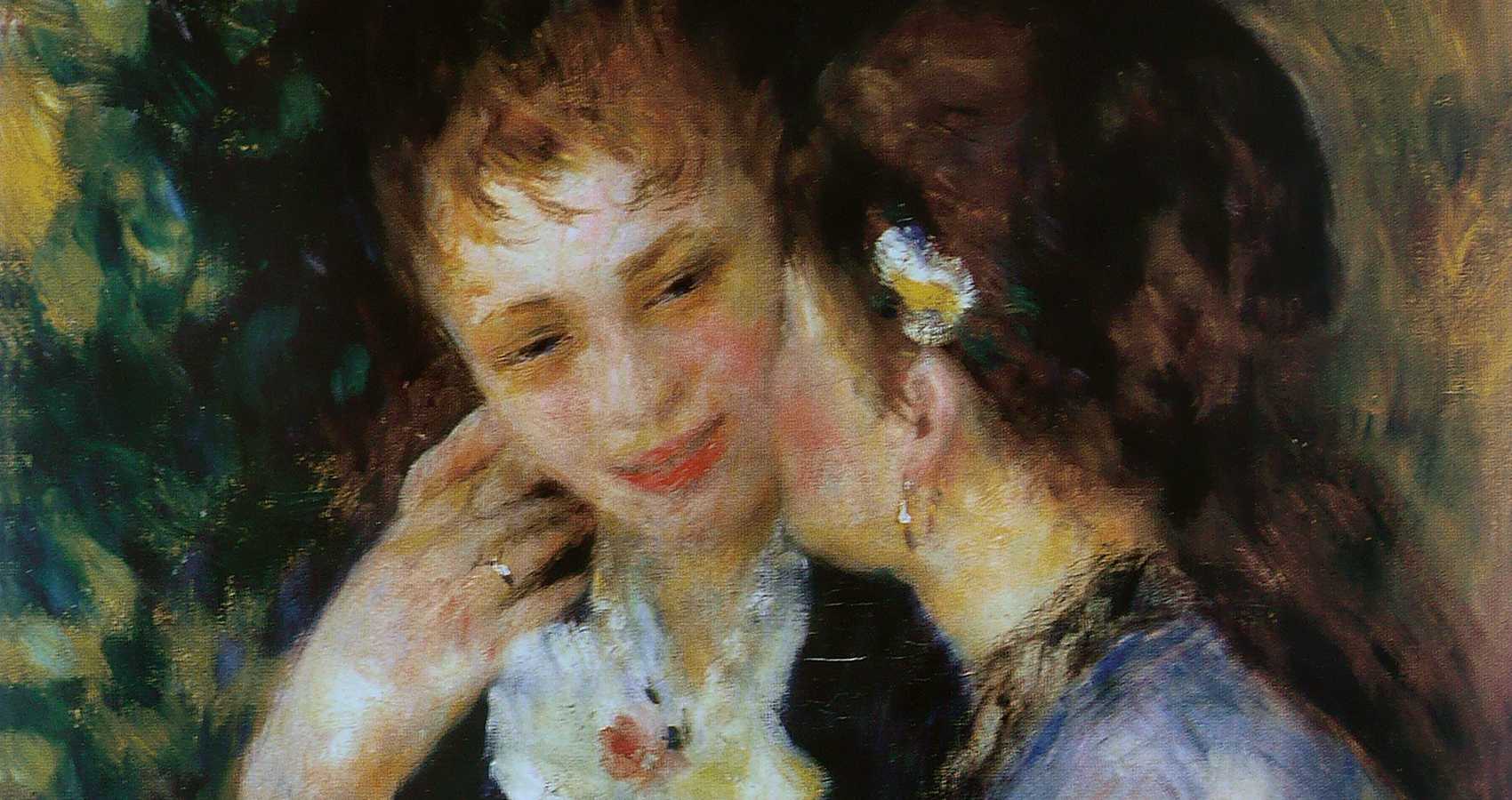Brittle Fragments
written by: Fay L. Loomis
I don’t remember how Louise and I met. We were students, older females, in the art department at Michigan State University in the 70s. She earned her M.F.A in sculpture, I an undergraduate and master’s degree in art history.
We shared another connection: our husbands were professors at MSU. Bill taught East and Central European history; my husband Herb lectured in the philosophy department.
After graduation, we were active in the art scene. That’s likely how we became friends. I remember seeing one of her large linear pieces, a woman on her hands and knees, on the wall at the back of a gallery. I was pulled into the drawing, read the words Louise had swirled below: “Am I crawling low enough?” The work brought me to my knees.
I put together Outdoor Sculpture in Michigan which included a travelling exhibition and a public form and guidebook for each of the communities of Grand Rapids, Kalamazoo, and Lansing. Louise led the public forum for Lansing. Seated next to her was Helen Milliken, First Lady of Michigan and supporter of the arts. The panelists and audience, dedicated to this somewhat esoteric subject, had a lively discussion. My friendship with Louse continued to unfold in interesting and unexpected turns.
Louise built two geodesic domes, one a communal studio, the other for her to cast large sculptural pieces. Her boldness blew me away. Louise never mentioned she was from the wealthy Connecticut Heublen family whose business interests included the sale of pre-mixed cocktails and A.1. Sauce. She didn’t flash her wealth, just quietly spent whatever she needed to whenever she needed to. She did tell me that as a child she and her friends would wander through neighborhood houses exploring exquisite objects. “We never took or destroyed anything,” she said in a quiet voice that suggested I accept her as she was. Wandering around in someone else’s house was something I couldn’t imagine ever doing.
I wrote a newspaper article about Louise’s piece Grandmother Steps, commissioned by her alma mater Dana Hall School to celebrate the 100th anniversary of the largest boarding day school for girls in America. The two portraits are tucked into an architectural detail at the Wellesley, Massachusetts school. Each piece is inscribed with quotes from famous female writers and artists, including words from Flannery O’Connor. “To the hard of hearing you shout, and for the almost-blind, you draw large and startling figures.” Quotations flowed as easily from Louise, who had an undergraduate degree in literature from Barnard College, as did her artistic creations.
Our strongest bond was probably our angst around love and marriage. Bill, born with a hearing problem, had gradually become imprisoned in a world of silence. Louise enrolled both of them in sign language and lip reading classes. They even took a leave of absence to go to a school for the deaf in New York City. She also put together a special sound system for their living room, so Bill wouldn’t be shut out of the lively conversations with friends that juiced up their life.
Louise eagerly learned to communicate in their new world. Bill didn’t. He was reluctant and often didn’t participate in Louise’s creative plans. Their relationship declined. “I’m thinking of getting a divorce,” Louise confided. “Never thought I’d be in this place. Bill shuts me out. We live in separate worlds. I can’t take it anymore. ”
“I’m sorry, Louise. Sounds tough. I hope you find a way through this.” She couldn’t know how her words tore through my heart. I was also contemplating divorce, though was unable to share my feelings with her, or anyone. While Herb had perfect hearing, he was also slowly disappearing into noncommunication, abetted by alcoholism.
As the middle child of seven, I had felt lost and looked forward to a relationship where I could share my thoughts and dreams. Herb and I met in high school and talked our hearts out about books and the kind of life we wanted to live. Our young bloom of ideas fell into a silence that eventually put a period at the end of our relationship.
A surprise entered Louise and Bill’s story. They relocated from the small Midwestern town of East Lansing back to New York City. Louise set up a studio on Bond Street, and Bill became a visiting lecturer at Columbia University. When I went to the city to visit my daughter, I stopped in at Louise and Bill’s expansive apartment overlooking the Hudson River.
Afterwards, we went to Louise’s warehouse-like studio where I met her assistant who was helping for a few months. She had described her working relationship in a letter. He is a Hungarian artist I’ve known for three years. We work well together. Bouncing ideas. His extra hands are a tremendous help… I’m getting a lot more done than if I were working alone. Not the big pieces, though. I’m a little worried about that. For them I need to be alone to work, and to date, I haven’t been able to free up the time. I witnessed the ease in their connection and couldn’t help but wonder if they were lovers.
Second surprise. Cancer burrowed into Bill’s body. Louise and Bill were forced to shift direction.
In a letter dated March 12, 1989, Louise spelled out her increasing quandary. Bill is suffering the effects of his chemo and I’m suffering the effects of his illness on my conscience. He said he’d do anything to keep me around; and a friend tells me, yeah, even get cancer. Strange, now the deafness and his response to it seem minor problems. I am worried that the C will metastasize etc etc. I get sort of mentally dizzy, can’t think about how to or if to leave. Awful. So I’m concentrating on work and spending more time at the studio. Not enough time though, because then I feel guilty and go uptown. I know that is a foolish swing, but I can’t seem to break it. And sometimes it’s just like old times, in that it all seems so graven in stone,
Bill and Louise, Louise and Bill (shades of Tristan Isolde, Isolde Tristan, Ein Mann ein Weib, Ein Weib ein Mann.)
Unlike Louise, I did get a divorce and later married Evarts, a holistic physician. Louise asked if he could recommend anything to help with the spreading cancer. Given the gravity of the disease, Evarts prescribed the words of Dag Hammarskjold, then Secretary-General of the United Nations. “For the yesterdays, thanks; for the tomorrows, yes.” I was disappointed that spiritual words were the only thing that could be offered; however, Bill and Louise expressed grateful thanks for the sustenance Hammarskjold’s wisdom brought into their lives.
In and out of hospitals, sandwiched in between teaching and travelling, Bill lived a few more years. Louise sent a brief note, inked onto a small yellow rectangle of paper, letting me know Bill had passed. Bill’s final days were loving – the girls and I were with him constantly for 6 weeks in Connecticut, where NEVER had I seen such daffodils. His room was a bower – Fay, you know how much he adored flowers! We got lots of talking down in the 10 months since he collapsed in Hamburg. It was worth the 10 operations to have had that time.
I didn’t know Bill loved flowers. What I did know was that he had decided to listen once more. While his cancer wasn’t cured, it seemed to me he was healed.
When I shared my thoughts with Louise, she was furious. “You weren’t there. You don’t know what my life has been like,” she wrote. I was stunned, felt like Louise had slapped my face. I didn’t understand her anger, nor why words meant to comfort stung this time around? Whatever I did, or didn’t do, was it worth sweeping away our friendship like chaff? Always sensitive to rejection, I wasn’t able to ask what was behind Louise’s outburst of rage or tempt rejection a second time. We never communicated again.
By the time Bill died, Louise’s career had opened up, spread internationally. She had written that friends had told her, Operate, Louise! … “Fine,” say I; but how? … I have to find a good gallery. Even though in NYC it’s like the search for the grail, I’m beginning to do it. Operate, operate operate. Louise did find her grail, A.I.R. Gallery, the first all-female artist cooperative gallery in the United States.
After Evart’s passing, I moved to New York, though didn’t share with Louise that I was two hours north of the city. I wasn’t able to get over Louise’s blistering last words.
Recently, I felt a strong pull to look up Louise on the internet. I discovered she had passed in 2020, after a long bout with Parkinson’s Disease. I also looked up Bill’s obituary. Surprised, yet again, I discovered that Bill had explored disabilities, including deafness, in the geographic area of his specialty. He hosted a conference and co-wrote a series of papers on the disabled community in the Soviet Union that was published in 1989.
In all of Louise’s restless feelings and thoughts, why did she never mention Bill’s disability project? Did it put Bill more in touch with his own disability or distance him further from deafness? Did the work create a wider wedge between them? I can wonder, though will never know the answers to my questions.
Friendships often fizzle over time. Some snap, as Louise and mine did.
Thirty years later, I get it. I wasn’t there, didn’t know what Louise’s life had been like. Today, at age eighty-six, I would ask the painful questions, accept whatever response Louise offered.
If I had been able to go beyond Louise’s acerbic words and connect with her wounded heart, perhaps I wouldn’t be left with brittle fragments.
- The Wind Bloweth Where It Listeth - December 9, 2025
- Bearable Lightness - February 26, 2025
- The Lover - January 21, 2025



